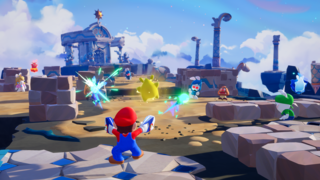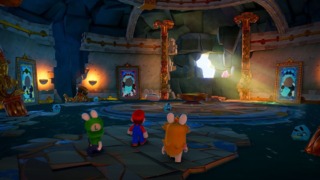For the first couple hours of Mario + Rabbids: Sparks of Hope, I anticipated a retread of my experience with the original game. “We gave Mario guns and put him in an XCOM” is a novel enough gimmick, but I found the battles and exploration in the first game too rote to keep my attention to the end.
Look at this dumbass.
Sparks of Hope doesn’t make a strong first impression, beginning with generic exposition about an alien force named Cursa that uses some goopy stuff called Darkmess to threaten the peace of this weird Mushroom Kingdom/Rabbid hellhole universe. And it doesn’t take long to introduce Edge, one of the most bafflingly designed characters I’ve seen in a while. This Rabbid is basically a Troll doll with a Joker color scheme, and she appears to be presented wholly unironically despite being named EDGE THE BLADE MASTER.
For the first handful of battles, I told myself I’d handle my misgivings about the Rabbids part of the “Mario + Rabbids” equation by only playing as Mario characters. That was until I realized that the real Peach’s barrier ability was effective, but the heal ability of the dumbass Rabbid Peach was infinitely more useful. Plus her rocket launcher can shoot up and over cover, allowing me to get easy shots on enemies that no other character could. Okay fine, I’ll betray my loyalty to the ‘real’ Mario characters for the sake of improved tactical options. This process happened again and again until I stopped caring about my distaste for the Rabbid stuff and got increasingly invested in each battle.
Oh right, in case you aren’t familiar with Kingdom Battle, I should mention that Sparks of Hope is a tactical strategy game in the vein of XCOM. But unlike its predecessor (and most other games in the genre), it doesn’t confine your characters to a grid. Instead, they have a limited range of free motion during each turn. This can be extended via the use of some fun abilities like team jumps, gliding, or power-ups.
This seemingly small change really added to my enjoyment of every turn. You’re able to quickly swap back and forth between characters without penalty, exploring your movement options before committing to attacks. By default, each character can do one team jump and one dash attack per turn, but this can be increased as you level up.
It’s really rewarding to explore synergies between character abilities in an effort to maximize your damage output each turn. Let’s say I’m in a battle that puts me up against numerous enemies that are weak against shock damage. I can start by throwing Bowser into the fray and using a spark ability (more on that shortly) to draw the enemies towards him. Then I can put Mario into an overwatch mode, which automatically fires upon enemies that are in motion. Enter Rabbid Peach, who I’ve leveled up so she has three dash attacks per turn and equipped her dash with a shock ability. I then slide into several enemies at once, popping them up into the air and activating Mario’s overwatch ability so he snipes them out of the sky like they’re clay pigeons. It felt great every time.
So, the sparks! Imagine the Luma from Mario Galaxy, but they have dumb Rabbid ears. And each one of them has an ability–it could add fire damage to your standard weapon blasts, create a shockwave of goo, reflect incoming damage back at your enemies, regenerate your health, or summon the spirit of Donkey Kong for a devastating radial blast.
Each character can have two sparks equipped at a time, and it’s very simple to slot them in and out at the beginning of battles or during exploration. It’s fun to try to optimize your spark loadout in a way that accentuates each character’s innate abilities. Rabbid Peach was my healer, so I gave her sparks that would reflect damage and revive teammates. Luigi was my sniper, so he got sparks that added fire and shock damage to his bow and arrow. Bowser was a beast with area damage, so he’d usually get sparks that gathered foes together or rained down destruction in a concentrated area. Sometimes you’ll go into a fight and realize that something’s off, whether it’s the characters you selected or the sparks you sent them into battle with. Thankfully, if you fail, it’s super easy to go back to the drawing board and assemble a new team with new abilities based on the challenges you encountered during your failed attempt.
I never grew tired of the many battles in Sparks of Hope and, thankfully, the exploration elements of the game have been improved upon as well. In the original, you just controlled the weird Roomba thing while your team followed along. This time around, you actually control Mario and your team…to an extent.
Here’s the thing. When I’m controlling Mario–the character who defined the platforming genre and who’s so synonymous with jumping that his original name was JUMPMAN–I’m used to a certain level of mobility and platforming ability. There’s something super weird about doing “collect eight red coins” challenges while controlling Mario but being constricted to little more than moving an analog stick. I get it, this isn’t a platforming game. But it still feels weird to be Mario while running around a 3D environment and not even being able to jump.
The puzzles themselves are fine distractions while you move from battle to battle, but aren’t anything that’ll surprise you if you’ve played a video game in the last 25 years. These Resident Evil Lite tasks will have you turning cranks, pushing blocks, and assembling missing pieces of paintings. None of them are particularly bad or frustrating, they’re just kind of things to mildly occupy your brain between the much more engaging battles. Still, it’s better than being a Roomba conga line leader like in Kingdom Battle.
I’ve enjoyed XCOM, Fire Emblem, and Advance Wars in the past but don’t consider myself an expert in tactical games, so I played with everything set to the default options and found the difficulty to be perfectly tuned for me. That said, a variety of accessibility and difficulty options should let you tune Sparks of Hope to your desired level of challenge whether you’re a veteran of the genre or if this is your jumping-on point. Enemy health and damage can be tweaked, as can the level of HP your heroes restore between battles. You can even set your skill tree to be automatically managed as you level up, or turn on full invulnerability if you’re struggling with a particular battle. These options combined with the child-friendly vibes of Mario and the Rabbids should make this an ideal entry point for younger gamers interested in the strategy genre.
Sparks of Hope wasn’t on my radar after my middling experience with Kingdom Battle, but I love it when a game surprises me like this. It takes just a handful of battles for the hooks to get in, and the tactical options only grow as you unlock new heroes and sparks. I’m not sure if any game could be good enough to make me love the Rabbids, but the fun I was having in my 30+ hours with Sparks of Hope did a great job of distracting me from their dumb, dumb faces.
Source: Giant Bomb Reviews Mario + Rabbids: Sparks of Hope Review




